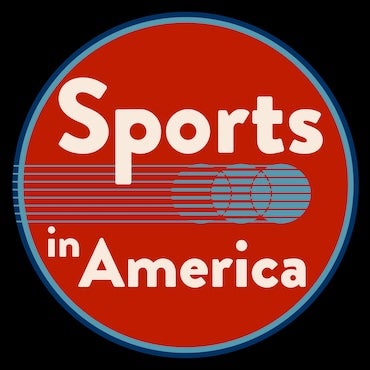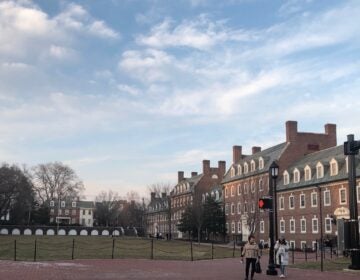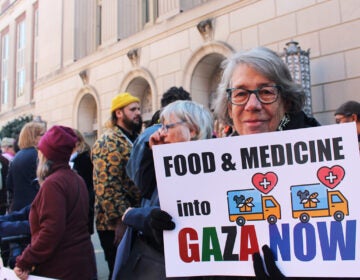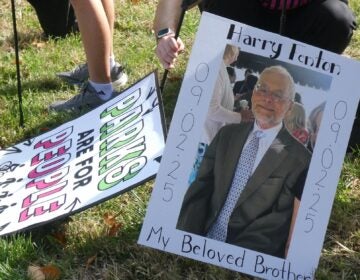Students and civil rights groups blast police response to campus protests
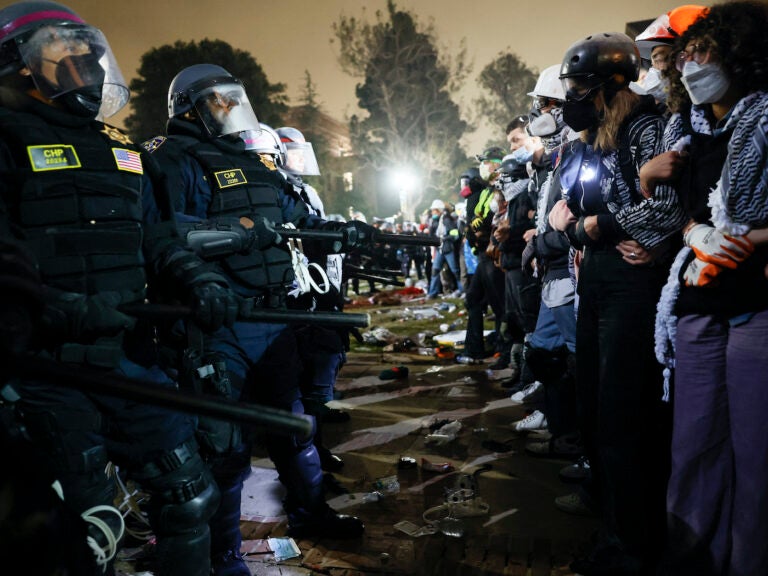
Police face off with pro-Palestinian students after dismantling part of the encampment barricade on the campus of the University of California, Los Angeles, early on May 2. (Etienne Laurent/AFP via Getty Images)
A broken ankle.
Concussions.
Tasered.
Pepper sprayed.
These are some of the claims of injuries stemming from police conduct — and inaction — from students and university faculty involved in pro-Palestinian demonstrations on university campuses in New York and Los Angeles.
Aidan Doyle, a 21-year-old junior at the University of California, Los Angeles, told NPR that the slow response from police, decisions made by university officials and the violence from counterprotesters would be things he’s unlikely to ever forget.
“The treatment of the protesters by the cops was horrible and unforgivable. But it was nothing compared to what the counterprotesters did assaulting 80, 90, 100 of us,” said Doyle, a member of the school’s pro-Palestinian encampment.
The students, like Doyle, and some faculty at universities across the country have spent the past few months protesting for Palestinian freedom. They’ve called on their universities to divest from companies that have businesses or investments in Israel because of the country’s military operation in Gaza.
These demonstrations have ramped up in recent weeks as students began erecting encampments on their school campuses, even taking over a school building to bring awareness to their cause.
University and police officials repeatedly demanded students disperse and take down their encampments, but protesters refused, arguing a right to free speech, and maintained that their demonstrations were peaceful. Some protesters at demonstrations, including at the University of California, Los Angeles, fought with counterprotesters.
Students and faculty, alumni, civil rights groups and some politicians allege that universities endangered public safety by calling in police in response to the protesters’ refusal to disperse. Some have said law enforcement used excessive, military-like force in their effort to clear some of the biggest student-run pro-Palestinian demonstrations and encampments in New York City and Los Angeles.
Days after police broke up the encampment and takeover of Columbia University’s Hamilton Hall, the New York City Police Department admitted that an officer accidentally fired his gun while inside the building. No one was hit by the bullet in that incident.
Isabelle Leyva, a senior organizer with the New York Civil Liberties Union, described “a consistent pattern of NYPD escalation at pro-Palestine protests” over the past few months. The organization is an affiliate of the American Civil Liberties Union.
The NYPD has responded to more than 2,400 protests and demonstrations since Oct. 7, and nearly half of them were related to the conflict between Israel and the Palestinians, Police Commissioner Edward Caban said during a press conference last week.
“And every one, we’ve worked to keep protesters safe and protect their First Amendment rights,” he said.
But Leyva said that last week’s protests in New York City were unlike anything she’s seen before. She worked with several monitors, including students, that observed the demonstrations at Columbia University and The City College of the City University of New York where police were called in to disperse student encampments on April 30.
“We saw, in my personal experience, the largest deployment of the NYPD that I’ve ever seen at a protest,” Leyva said. She saw violence during the arrests of people outside of campus that were protesting during the NYPD’s raid on Columbia’s Hamilton Hall.
In Los Angeles, students at UCLA reported being struck by rubber bullets fired by a massive police response to the demonstration at the school while also witnessing officers reportedly delaying their response as counterprotesters rained sticks, fists and rocks onto their encampment.
More than 2,100 people have been arrested on college campuses across the country over the previous two weeks on universities across the U.S, according to a tally from the Associated Press.
On Monday, tense interactions between protesters and police were still being reported. Columbia leadership requested a police presence through May 17, until commencement activities for the school were over.
UCLA’s chapter of the Students for Justice in Palestine reported more than 45 students, other members of the university, members of the press and lawyers were arrested at 6 a.m. Monday by the members of the Los Angeles Sheriff’s Department and the Los Angeles Police Department. At the time, UCLA SJP said, no students were protesting. The group also alleges that police kept these students on the ground in handcuffs for hours.
In New York protests, police used a controversial specialty unit
Russ Hicks, a longtime police academy trainer in Washington state, told NPR’s Martin Kaste that to have a larger response from law enforcement is safer, both for officers and for the protesters.
“What you don’t want is a handful of five officers managing a large crowd because that’s when things get out of control,” Hicks said. Officers may end up “using too much force because they don’t have enough people,” he said.
But Molly Biklen, the NYCLU’s associate legal director, argues that police arriving in such large numbers, as was the case at Columbia and City College, “often leads to escalation rather than de-escalation.”
The NYPD’s controversial Strategic Response Group (SRG) was brought in to break up the student encampments on the night of April 30. The SRG “responds to citywide mobilizations, civil disorders, and major events with highly trained personnel and specialized equipment,” according to the NYPD’s website.
The NYCLU has long called for the dissolution of the SRG, saying it is “a violent, overfunded, and unaccountable unit of the NYPD notorious for its abuse of protesters, particularly those standing up for racial justice.” The SRG has also drawn condemnation from Human Rights Watch.
The NYCLU filed a lawsuit over alleged aggressive over-policing from the NYPD during Black Lives Matter protests in 2020. Last September, a settlement was reached that mandates the NYPD will only be allowed to deploy the SRG under certain conditions. Not all provisions have been fully implemented, Biklen said.
The New York Police Benevolent Association, the police union, said it intends to appeal the settlement, calling it “misguided” and dangerous to the lives of frontline officers.
Biklen said other universities have responded “with dialogue” and in other ways.
“There’s a number of ways to respond,” Biklen said, “that just don’t involve throwing hundreds of cops at problems. That has been a way in which society has tried to respond to every single problem that we have in a city. And, I think we’ve seen that that is not the answer.”
Officials claim some protesters weren’t students and that they threatened safety
Police in New York City and the Mayor Eric Adams have repeatedly said that about half of the people arrested at Columbia and City College are not currently affiliated with either school — allegations the schools are repeating.
City officials said 29% of the 112 people arrested at a protest at Columbia last week were not affiliated with the school. At the City College protest, 60% of the 170 arrested were not affiliated with the school, according to the city’s press release.
The NYPD has not directly responded to NPR’s repeated requests to get clarification on how the department and Adams have made that determination.
Police said school officials have said they made the decision to call in extra security measures in response to “violence and vandalism” — not because the students were holding peaceful protests.
Since October, “there has been a pattern of demonizing protesters specifically that are protesting in support of Palestinian Liberation,” said the NYCLU’s Leyva. “When we start to paint protesters as outside agitators, as terrorists, as people who want to harm the city, etc. in the public’s mind, that allows people to justify mass police presence, including police violence and mass arrests.”
NPR has submitted a Freedom of Information Act request for police body camera footage from law enforcement agencies in New York and Los Angeles.
In response to the encampment at UCLA, officers from multiple units arrived including the Los Angeles County Sheriff’s Department, the California Highway Patrol, the Los Angeles Police Department, and the UCLA Police Department.
“The Sheriff’s Department is committed to protecting people’s constitutional rights and their right to exercise free speech,” the agency said in a statement to NPR on Monday. “However, when actions turn violent and cross the line into criminal misconduct the Department will intervene and enforce the laws appropriately. We encourage the public to protest peacefully and listen to law enforcement instructions.”
The California Highway Patrol confirmed to NPR that officers responding to the demonstrations “utilized aerial distraction devices” that didn’t come into physical contact with anyone. When certain demonstrators threatened officers by throwing objects and weapons, the CHP said “sponge rounds and bean bag rounds were used on a limited basis in response. The CHP did not deploy any chemical agents during this incident.”
The LAPD referred NPR to UCLA police, which didn’t respond to a request for comment.
A student says he will never forget what happened at UCLA
A large number of police arrived at schools in New York City and Los Angeles, dressed in riot gear, some holding shields and batons.
Graphic videos and images have emerged of violent clashes on the night of April 30 and May 1 between pro-Palestinian student demonstrators and counterprotesters on the UCLA campus. Videos on social media showed law enforcement standing off to the side during the fighting and shooting rubber bullets into the melee.
Doyle, the UCLA junior, said he joined the encampment on the school’s Royce Quad the week before arrests were made calling it peaceful.
He allowed NPR to use videos he shared of his experience at the encampment on Instagram.
On Sunday, April 28, a pro-Israeli rally started near the encampment. Nothing violent happened, but tension was brewing, Doyle said. Pressure continued to mount when on Tuesday, April 30, things erupted. That’s when a large group of counterprotesters surrounded the encampment, hurling fireworks, sticks and other items.
Doyle said he was hit in the face with a rock and a plastic traffic cone.
Counterprotesters continued to attack the encampment throughout the night, including hitting students with pepper spray and other chemicals, he said.
“I saw a girl probably 20 years old, being struck in the face by men who are counterprotesting. It was one of the most disturbing things I’ve ever seen,” Doyle said.
At around 2 a.m., Los Angeles Mayor Karen Bass tweeted that LAPD officers were responding to the violence and said that the “violence unfolding this evening at UCLA is absolutely abhorrent and inexcusable.”
Police arrived at around midnight or 1 a.m., from Doyle’s recollection.
“We watched as they lined up on the hill alongside the counterprotesters, and they stood there and did nothing,” he said.
The LAPD confirmed that its officers, along with other state and local law enforcement agencies responded.
“Once mutual aid resources were formed and coordinated, they separated the two groups. No arrest were made, no force was used, and no officers were injured,” the LAPD wrote on X.
Students, including Doyle, returned to the encampment the next night, on May 1, despite the attacks from the night before.
That’s when more than 200 pro-Palestinian protesters were surrounded by Los Angeles police and were arrested. LAPD Chief Dominic Choi said 210 arrests were made by the UCLA Police Department for failure to disperse and that he was “thankful there were no serious injuries to officers or protestors.”
But the UCLA Palestine Solidarity Encampment said police “tore students from our human chain and shot rubber bullets at close range. Many were rushed to the ER after the bullets connected with heads and hands.”
Doyle said he and hundreds of other protesters were handcuffed and bundled into buses where they stayed for hours before getting to the police station.
“We were in the bus for something like 4 1/2 hours,” he said. One of his fellow demonstrators requested a trip to the bathroom, which was ignored, Doyle said. Eventually, Doyle said, that person defecated on himself.
UCLA Chancellor Gene Block issued a statement defending the decision to call in law enforcement.
“Several days of violent clashes between demonstrators and counter-demonstrators put too many Bruins in harm’s way and created an environment that was completely unsafe for learning,” Block wrote. “In the end, the encampment on Royce Quad was both unlawful and a breach of policy. It led to unsafe conditions on our campus and it damaged our ability to carry out our mission.”
Block has said the attack on the encampment from counterprotesters will be investigated and “may lead to arrests, expulsions and dismissals.”
City College violence was “more aggressive” than Columbia’s, civil rights group says
The images that emerged from the NYPD’s response at Ivy League Columbia University were striking.
As media attention was trained on Columbia, students at City College faced violence “even more aggressive than what we saw outside of Columbia,” Leyva said.
This kind of response is even more striking and layered because City College has more students of color “who are already impacted disproportionately by policing and police violence,” Leyva said.
NYCLU’s protest monitors saw pepper spray and tasers being deployed, students being beaten and sustaining injuries, she said. Arrests continued well into the early hours at City College.
“Around campus is where we documented the bulk of the violence. So that was six or seven police on top of one person for arrest, pushing people onto the sidewalk, using barricades that were lifted and then arresting those people on the sidewalk, despite the fact that the orders to avoid arrest was to go onto the sidewalk,” Leyva said. “This was all in an effort to keep people as far away from campus and being able to see what was going on.”
In a recent statement, the CUNY Gaza Solidarity Encampment said, “We reject the claim that there was violence against any officer from a member of the encampment or a supporter since their injuries were a consequence of their own pepper spray,”
Corinna Mullin, an adjunct assistant professor in the Department of Political Science at John Jay College, said the police raid on the City College encampment “was a horrifying experience.” Mullin supported the students’ cause and stood alongside other faculty members. She spoke last week at a press conference organized by student protesters.
“We were surrounded on all sides by hundreds of police officers. It felt like a military invasion. It was terrifying — terrifying. I’ve never experienced anything like it before. There was an unnecessary and excessive use of force,” Mullin said.
She detailed witnessing police batons pressed against protesters’ necks and chests. Once in jail, people were left standing, denied water and access to a bathroom for hours, she said. She also witnessed a Muslim woman’s hijab being removed from her head.
9(MDAzMzI1ODY3MDEyMzkzOTE3NjIxNDg3MQ001))
